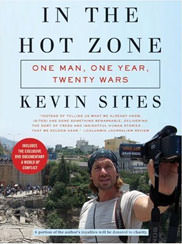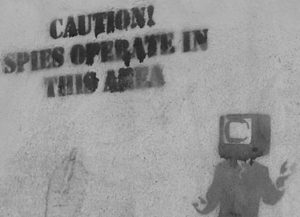Mark Sarvas on ‘The Hot Zone’
As the first Internet reporter for Yahoo News, Kevin Sites spent a year of living dangerously covering 20 wars all over the world. Is Web journalism the wave of the future? Mark Sarvas, a pioneer of literary blogging, takes a close look.
The book publishing industry’s hunger to capitalize on the audiences of popular Web sites and bloggers has recently led it to make some risible creative choices which suggest a questionable grasp of the strength of either medium. We may accept the short and choppy online, and perhaps we even seek it out: easily digestible nuggets to enjoy during the course of a busy day. But when we settle down with a book, most of us seek a different experience. The Web does certain things uniquely well, coupling immediacy with multimedia and a profound sense of interconnectedness, courtesy of the humble hyperlink. Books, on the other hand, draw their strength from depth, reflection, gestation. Writers — and publishers — forget this at their peril. And so, the lamentable and increasingly common Web-to-book transition is seldom a smooth one.
In 2005, Kevin Sites was a freelance war reporter working for NBC News, in hot water for his controversial video of an American solider killing an Iraqi in a Fallujah mosque. Unable to advance his career with NBC, he jumped when offered the opportunity to launch a Yahoo website: Kevin Sites in the Hot Zone. His vision for the enterprise was pitched in the best Hollywood high-concept tradition: “covering every armed conflict zone in the world within one year.” Even two years ago — an epoch in Internet years — he already had apprehended enough about the multimedia nature of the Web to realize that content should include “at least one 800-1200 word text dispatch, a still photograph slide show and a couple of video clips.” He set to his ambitious agenda, and the results of his efforts remain online for all to see.
It’s clear that Sites sees himself as part Ernie Pyle, part Robert Capa and part Edward R. Murrow, and, in this regard, his Web site is both utterly traditional in its sensibility as well as unique and even potentially revolutionary in its focus, design and execution. Without editors and segment producers to report to, Sites is his own man, using his laptop and satellite modem to bring us unfettered war coverage from around the world, and, as with the proverbial Chinese menu, you can choose text from column A, photos from column B and videos from column C.
At his best, the tireless Sites displays a clear grasp of the landscape in the 20 hot spots he visits. He can write clearly, if plainly, and has a natural eye for the compelling human interest story. It is, of course, difficult to judge retroactively, but the gradual unfolding of these tales during 2005 and 2006 must have been compelling in its immediacy.
At his worst, however, he places himself at the center of the narrative, overwhelming it, more interested in his feelings and impressions than his subjects and surroundings. In the entries headed “Kevin’s Diary,” intended to offer a more personal view, this is understandable if regrettable. But, in the tradition of his war correspondent antecedents (including Pyle and Murrow), he also inserts himself at times into his straight news coverage, generally to deleterious effect. But as the comments left behind on his Web site indicate, the tales Sites brought back resonated with many readers who didn’t appear to mind his narrative intrusions. And so, when the assignment came to a close in September 2006, Sites took the inevitable next step, and now we have “In the Hot Zone: One Man, One Year, Twenty Wars,” his Web site in book form, published as an original trade paperback by Harper Perennial.
Historically, when war correspondents settle down to write books about their experiences, it’s usually an attempt to take the long view, to bring context to events that swept them along the first time around. If journalism is the first draft of history, the book-writing correspondent is lucky enough to have a crack at the second draft, too — an opportunity Michael Herr, to cite one example, took to spectacular effect with “Dispatches.”
Unfortunately, to paraphrase Lloyd Bentsen, Kevin Sites is no Michael Herr. We are raised to believe we cannot judge a book by its cover, but here the temptation cannot be resisted. The book’s cover photo shows Sites, prominent in the foreground, handheld video camera turned on himself, dominating a tableau of destruction in the distance. And in book form, the narcissism, earnestness, self-importance and melodrama that can be selectively sidestepped on the Web site are thrust to center stage. This is not a book for someone who wants to know about Vietnam, Haiti, Iraq, Congo or the 16 other hot zones Sites visits. The real subject of this book is Kevin Sites.
Most of the book’s content is drawn directly from his Web site. Some pieces are reworked with new material, others are reprinted verbatim. But, in his decision to use “In the Hot Zone” to document his personal journey, Sites has stripped from the book the most valuable and illuminating sections of the Web site. The book is one long “Kevin’s Diary” entry: all impressions, no analysis. Read individually and over time, Sites’ essays can be engaging and even informative. Taken together, they become an unendurable parade of self-regard.
Part of the problem is that the book suffers from the Web site’s underlying gimmick, which particularly suffers in the transition into print. The need to say something about 20 conflict zones means they are all necessarily short — and correspondingly shallow. The book leaves one with the impression that Sites zipped into town, looked for the right human-interest story, found it and departed. This is ironic and points to an organic flaw into whole Web-to-book form: Readers of the more expansive Web site will clearly see this was not, in fact, his modus operandi. The Web site is comprehensive and varied, whereas the book has a rushed, hit-and-run feeling. Section headings — sometimes as many as six to a page, some separating no more than a paragraph of narrative — are clearly meant to evoke the experience of reading a blog, but that seems a mistake, augmenting the book’s hurried feel.
One can also disagree with the linchpin of Sites’ strategy: his earnest decision to “focus on the small stories” and “strong, character-driven narratives about people you might not know, but whom you learn to care about once you are taken into their worlds.” It’s a sad irony that Sites ends his tale enraged that his method hasn’t resulted in a generation of informed, engaged Americans. But to what extent does a Hallmark movie engage or inspire? It might move, it might manipulate the heartstrings — but in our voyeuristic age it’s all too easy to cluck sadly as we read and then click away.
It doesn’t help that Sites’ writing can veer from the simply lousy (one girl is described as “itching her arms and legs” and Israeli soldiers wear “Jewish yarmulkes”) to the embarrassingly melodramatic. Here he is on a pregnant 15-year-old in Uganda:
“There is anger, sadness, silence; the confusion of just how the bones of fortune were shaken and thrown in her particular case. She is, at this tender age, both victim and defiant, captive and free, wronged and avenged, child and mother.”
When he’s not portentous, he’s self-absorbed, endlessly reflecting on the importance of what he’s doing, the insignificance of what he’s doing, the difficulty of what he’s doing and the virtues of what he’s doing. How many times must he tell us that he juggles three media — writing, video and stills? All this self-involvement might still be interesting if he used the book to explore, for example, the toll of this exercise on his emotional life. But the closest we get is this gloss, explaining why he prefers e-mailing his girlfriend to calling her: “Wading chin-deep in the misfortune of others for so long has shriveled my capacity to interact in a normal way.”
It’s a missed opportunity, and one wishes Sites had shown the same courage within his interior landscape that he clearly shows ducking bullets and mortar fire. (The title, it should be noted, is an oversell. As Sites’ own appendix notes, only nine of the 20 countries visited are in “active” conflict.)
There are some strong, affecting passages in “In the Hot Zone,” but they are dismayingly rare. The Vietnam chapter, though brief, hints at something bigger and better. An essay on Iran’s heroin problem achieves a rare balancing act of placing individual stories in a context which illuminates a larger problem. And when Sites allows American soldiers to speak for themselves, they speak with a humility that should have inspired him more than it did.
Still, Sites’ self-absorption is scarcely without precedent. The relatively young business of reporting war has always attracted men and women of a peculiar constitution. For every William L. Shirer and David Halberstam, there are dozens of lesser lights: vain adventure seekers, lazy stooges, drunks and outright liars. The Crimean War correspondent William Howard Russell, considered by many to be the first war reporter, called himself “the miserable parent of a luckless tribe” with good reason.
Perhaps it’s because war attracts outsized personalities — Winston Churchill spent part of his early career as a war correspondent, filing memorable dispatches from the Boer War — that war reporters, nearly uniquely among news reporting, make themselves part of the stories they cover. Opinions and observations might find their way into political coverage and sports reporting, but one seldom finds the reporter embedded so directly in his narrative in any other form of news reporting.
Still, it’s difficult not to admire all but the most inept of these men and women. They toil under conditions of extreme danger and deprivation, mistrusted on all sides, unable by virtue of their vantage point to perceive the whole of what they see. But when they get it right — as John Hersey did, brilliantly, in his landmark “Hiroshima” — they are an indispensable part of the historical record.
At the opposite end of the spectrum, Sites’ book should stand as a cautionary tale, a reminder that the virtues of a compelling Web site — immediacy and impressionistic brevity — wilt and fray when pressed between the covers of a book.
Mark Sarvas, creator of the literary blog The Elegant Variation, is the author of “Harry, Revised,” a novel to be published in 2008 by Bloomsbury.
Your support matters…Independent journalism is under threat and overshadowed by heavily funded mainstream media.
You can help level the playing field. Become a member.
Your tax-deductible contribution keeps us digging beneath the headlines to give you thought-provoking, investigative reporting and analysis that unearths what's really happening- without compromise.
Give today to support our courageous, independent journalists.







You need to be a supporter to comment.
There are currently no responses to this article.
Be the first to respond.